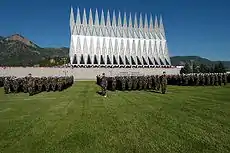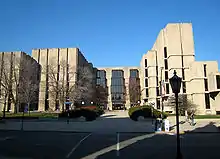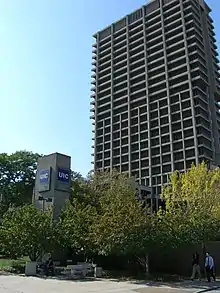Walter Netsch
Walter A. Netsch (February 23, 1920 – June 15, 2008), was an American architect based in Chicago. He was most closely associated with the brutalist style of architecture as well as with the firm of Skidmore, Owings & Merrill. His signature aesthetic is known as Field Theory and is based on rotating squares into complex shapes. He may be best known as the lead designer for the United States Air Force Academy in Colorado Springs, Colorado and its famous Cadet Chapel. The Cadet Area at the Academy was named a National Historic Landmark in 2004. He was a fellow of the American Institute of Architects.


Overview
After graduating from The Leelanau School, a boarding school in Michigan, Netsch studied at the Massachusetts Institute of Technology, and then enlisted in the United States Army Corps of Engineers. He earned his bachelor of architecture from the Massachusetts Institute of Technology in 1943 and began his career as an architect working for L. Morgan Yost in Kenilworth, Illinois. In 1947, he joined Skidmore, Owings and Merrill, which initially assigned him to work in Oak Ridge, Tennessee. Later he became a partner for design in SOM and remained with the firm until 1979. He began his own practice in 1981.[1]

Following his work on the Air Force Academy, Netsch led the team which designed the original University of Illinois Circle Campus. The campus design grouped buildings into functional clusters and now constitutes most of the east campus buildings at the University of Illinois at Chicago.[2] During his career, Netsch designed 15 libraries, as well as academic buildings for colleges and universities in the United States and Japan, including Northwestern University, Miami University, Wells College, Illinois Institute of Technology, Sophia University, Texas Christian University, University of Chicago, and University of Iowa. He did the initial design for the Inland Steel Building in Chicago; built circa 1956-1957, this was the first skyscraper built in the Chicago Loop after the Great Depression.[3] He also designed the east wing of the Art Institute of Chicago.[4] Netsch designed several buildings at Northwestern University and the campus and buildings of Montgomery College in Takoma Park, Maryland, and was the focus of an exhibit at the Northwestern University Library in February–March 2006[5] as well as a monograph, Walter A. Netsch, FAIA: A Critical Appreciation and Sourcebook, published in May 2008.[6]
Recognition
Netsch taught at several universities, received numerous awards and honorary degrees, and served as a trustee at the Rhode Island School of Design and a member of the Board of Governors at Northwestern University Library. From 1986 to 1989, he served as Commissioner of the Chicago Park District, appointed by Mayor Harold Washington.[7] He was elected to the College of Fellows of the American Institute of Architects in 1967. He was affiliated with the Art Institute of Chicago and the Landmarks Preservation Council of Illinois. He served on the U.S. Commission of Fine Arts from 1980 to 1985.[8] In 1995, Netsch was interviewed for the Chicago Architects Oral History Project.[4]
Netsch was a collector and patron of the arts, along with his wife, Illinois politician Dawn Clark Netsch, whom he married in 1963. The couple's art collection has been exhibited several times.
Netsch maintained a private consulting practice and was viewed as a mentor by many architects.
References
General
- Blum, Betty J. (1995). "Walter Netsch (1920-2008)". Oral Histories (Architects). Art Institute of Chicago. Retrieved 2017-09-02.
- Northwestern University Library (2008). Walter A. Netsch, FAIA: A Critical Appreciation and Sourcebook. Northwestern University Press. ISBN 978-0-8101-2541-4.
Notes
- Thomas E. Luebke, ed., Civic Art: A Centennial History of the U.S. Commission of Fine Arts (Washington, D.C.: U.S. Commission of Fine Arts, 2013): Appendix B, p. 550.
- "The Circle Campus: Circle Campus Design". UIC Library - Archives - Exhibits. Retrieved 24 February 2017.
- "Walter Netsch Biography". Northwestern University Library. Archived from the original on 2010-05-25. Retrieved 29 January 2008.
- Blum 1995.
- "Walter Netsch and the Northwestern University Library". Archived from the original on 2010-05-25. Retrieved 29 January 2008.
- Northwestern University Library 2008.
- Netsch takes his wine and cheese to the parks. Chicago Sun-Times, July 6, 1986
- Luebke, Civic Art.